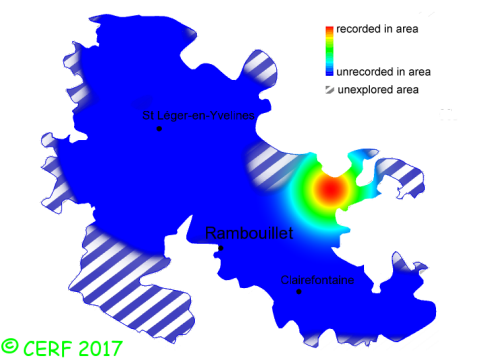|
Tricholoma focale (Fr.) Ricken
|
common name(s) : Booted Knight
New classification: Basidiomycota/Agaricomycotina/Agaricomycetes/Agaricomycetidae/Agaricales/Tricholomataceae
Former classification: Basidiomycota/Homobasidiomycetes/Agaricomycetideae/Tricholomatales/Tricholomataceae/Tricholomatoideae/Tricholomateae
(unconfirmed synonyms: Agaricus focalis)
edibility : poisonous
|
|
|
The cap is red-brown to reddish orange, convex then expanded, sometimes slightly umbonate; its margin is smooth, inrolled a long time.
The cap surface is with almost scaly radiating fibrils, slightly sticky, especially in the youth.
The stem is creamy white at the apex, girdled with scaly bands concolorous with cap on a creamy brown background below the protruding ring zone, tapering at the base, with a woolly protruding ring clearly marking the separation between the two zones of the stem.
The flesh is white, unchanging or possibly reddening a bit; its taste is mealy, mild to slightly bitter; the odour is mealy;
its texture is fibrous.
The gills are white then cream, spotted with brown with age, emarginate, crowded, narrow .
The spore print is white. This species is mycorrhizal.
It grows on the ground, mostly in coniferous woods, in coastal regions, on a rather sandy and poor soil, mostly with Scots pines, evergreen oaks, Aleppo pines.
The fruiting period takes place from September to November.
| Dimensions: | width of cap approximately 9 cm (between 3 and 15 cm) |
| | height of stem approximately 9 cm (between 5.5 and 12 cm) |
| | thickness of stem (at largest section) approximately 11 mm (between 2 and 20 mm) |
Chemical tests : none.
Distinctive features : Red-orange brown cap, with almost scaly radiating fibrils; stem with woolly ring, separating a white part above from the copper-coloured scaly bands below; mealy odour; usually with pines in sandy coastal areas
Tricholoma focale is rare and confined in the forest of Rambouillet, and is quite rare, more generally speaking
.
|  | | Above : distribution map of Tricholoma focale in the forest of Rambouillet |
|
page updated on 14/01/18